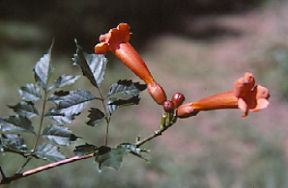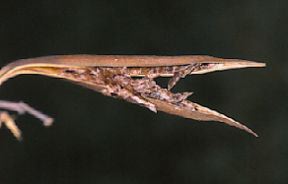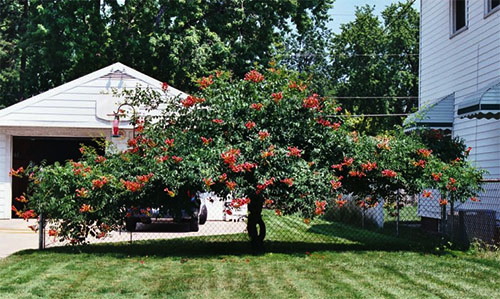|
home: www.rubythroat.org |
|
|
home: www.rubythroat.org |
|

© Bill Hilton Jr. If you have a sharp photo of this hummingbird flower you would like to contribute for this page, please send it to PROJECTS with info about when and where the photo was taken, the photographer's name, and any anecdotal info about the plant. |
Trumpet Creeper, Campsis radicans, is a native vine found throughout nearly the entire breeding range of the Ruby-throated Hummingbird. Robust and aggressive, it is best planted at the base of a fence or tree where it can be trimmed back. With support, it can grow 20m high with a main vine nearly 15cm in diameter. Flowers occur on new growth each summer, from late May through mid-September in the Carolinas; the growing season is shorter to the north, slightly longer in the southern U.S. Trumpet Creeper blooms profusely in full sun, less so in partial shade. |
| Trumpet Creeper, also called "Cow-Itch" because it causes mild dermatitis in some people, can be purchased from native plant dealers; cultivars in yellow or deep red are available from garden nurseries. It may be transplanted from roadside areas where it is likely to be cut or sprayed by highway crews, or can be grown from its winged seeds (right), collected in early fall from a long brown pod. Although some folks consider this plant a weed, it is a VERY valuable native hummingbird flower. |

© Bill Hilton Jr. |
 |
|
| As shown by this photo from Rob Downs of Toledo, Ohio, Trumpet Creeper can even be trained to grow rather symmetrically on a wire fence. One can hardly argue that this vine/shrub isn't an attractive addition to the yard. | |
|
CULTIVATION TIPS |
|
| Perennial deciduous vine (to 20m with support) Blooms early summer to early autumn, on new growth Average well-drained soil |
Full sun provides best blooming Zones 4-9 |
| NOTE: We are not horticulturists, so we regret we can't answer specific questions about how to plant and propagate native hummingbird flowers, but your local agriculture extension office or Master Gardener group may be able to help. We're also unable to provide names of sources from which you can order native plants. Please do NOT collect native plants from the wild unless they are growing in a site under immediate threat from development; instead, try to find a reputable nursery near you that raises native plants from cuttings or seeds. | |
|
Back to "Top Ten" Native Hummingbird Plants; forward to #2 Beebalm or Oswego Tea Up to Top of Page |
|
Make direct donations on-line through
Network for Good: |
 |
|
LIKE TO SHOP ON-LINE?
Donate a portion of your purchase price from 500+ top on-line stores via iGive: |
|
|
Use your PayPal account
to make direct donations: |
|
|
|
Share Your Hummingbird Experiences Through "Hummingbird Hobnob" |
 |
Operation |
|
|